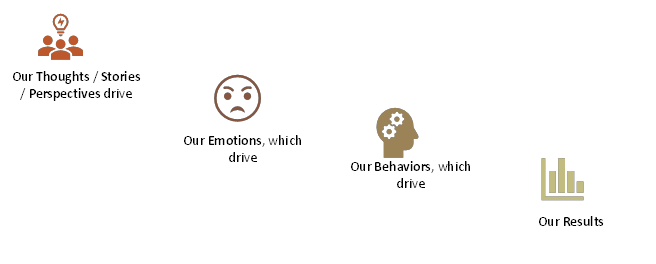This starts with a personal story,
a career moment I’m not too proud of.
Anyway, we received some bad press and our senior leadership team, specifically myself and the CFO, had differences in how to manage the situation.
I was of the mind to not engage directly with the specifics but to provide the media with how we typically operate and all the success we’ve had with the majority of our students. The CFO felt we needed to be very direct and speak to the specific complaints of this student to minimize the damage to our reputation. I felt this approach would only extend the story and do more harm than good.
I don’t actually know who was right about that. But I do know the CFO, who is actually a very good guy, and I got into a battle far deeper than just this situation. We argued loudly and rudely and personally. And I remember doing something which was quite unusual for me and hadn’t done before or after: I stood up at a dinner of the senior team and yelled, ‘F—- YOU!’
Not my best moment.
Here’s my point: while the topic was this media situation, the real challenge (the BIG A Agenda) was our mindsets or the perspectives or stories we were holding about our roles and each other.
My Mindset (the Story I was telling myself):
- Communications and PR is MY area
- You’re questioning my experience and capability
- This is your pride speaking, not the welfare of the organization
The CFO’s Mindset (the Story he was telling himself)
- This is a company I helped build and it’s really important to me
- This student and the media is being unfair to us
- We need to defend ourselves
- Andy isn’t being aggressive enough
Comparing the perspectives, you can see where the conflict would arise. We were seeing the same set of facts very differently and holding fast to the story we’d each built around it.
Here’s a model for this which can be helpful in considering how our mindset as a leader can impact our success (or lack thereof).

So, it begins with our thoughts or the stories we take on, which influences how we feel and how we act.
As an example, if a valued team member says to me, ‘This is the worst place I’ve ever worked!’, I have the opportunity to evaluate it in a number of ways:
One Way to Look at an Interaction
What she said (the fact): This is the worst place I’ve ever worked!
One way I can interpret it (the story I take on): Well, I guess she hasn’t worked in many places or she’d understand how good she has it here.
The Feeling or Emotion in Me: Frustration? Impatience?
What action might I take as a result: Dismiss her concerns and move on
A Second Way to Look at the Same Interaction
What she said (the fact): This is the worst place I’ve ever worked!
One way I can interpret it (the story I take on): Something systemic is going on in her area that isn’t good
The Feeling or Emotion in Me: Concern? Curiosity?
What action might I take as a result: Ask her what she means by this, what she’s experiencing
_____
You can see how the stories we take on directly affect the actions we choose and, of course, the results we get. You can see how the outcome of the situation will likely be quite different in interaction 2 versus interaction 1, just based on my interpretation of the facts (the story I choose to hold about the facts).
This happens, of course, because our brains are always trying to create order and sense out of our experiences. So we apply what’s happened to us in the past along with the signals we’re getting to make up a story, or interpretation, of the facts. This story gives us confidence on how to move forward. It’s an effective path of evolution but it doesn’t always serve us as leaders in the moment or getting the most out of our people. This tendency to create protective stories based on limited insight has been called the Ladder of Inference. Here’s a fun, short video on this which lays it out beautifully:
The good news is that we have the ability to adjust our thoughts which directly affects our outcomes: Change your thoughts, change your results.
So, what to do about it? Here’re four tactics you can put in place today which can help ensure you’re taking on stories which positively and powerfully serve you and your team.
1. Set intention prior to meetings or interactions. I often ask my clients, ‘How do you want to show up in this meeting/presentation/conversation? What demeanor do you want to reflect in this interaction?’ The idea is that we can set intentions for how we are going to operate and it can help set the right tone. You might decide, ‘I want to show up curious or open or commanding or confident…’, depending on the situation. The point is that it’s more likely to happen if you set an intention for it- your brain will try to make it so.
2. Have a contingency plan for if things don’t go as planned. The brain dislikes making decisions. It’s a very energy intensive exercise for the brain. That’s why a day of Zoom meetings can be so exhausting. The brain prefers, instead, to already have a decision or a plan in place. So, prior to a meeting or conversation, determine what might happen and have a plan for it. Example: ‘If she says that she’s dissatisfied with my work, I will choose to take a breath, repeat what I heard in my own words and then share the data.’ Having a plan in place will reduce the chance of you freezing or becoming triggered in the moment because it will reduce the threat you are feeling.
3. Pay attention to those moments when you feel triggered. Nearly all of us become reactive or triggered at some points in our lives. So how do we move from being reactive (reflexive, driven by emotion) to being responsive (driven by thoughtfulness and experience and judgement)? One way is to consider the stories we’ve told ourselves about these situations and determine if that story or perspective is serving us. Perhaps there’s another story which also is based on the facts but is more empowering for you. If a colleague says something which I feel is curt and thoughtless, I have at least a couple of choices on what story to make up about it:
- She doesn’t care about me, she’s only looking out for herself. (My response here is likely to be firing back at her, to be closed off.) OR
- Wow, this is an unusual reaction. I wonder what might be going on? (My response to this might be curiosity and/or compassion. )
Byron Katie offers these questions to examine the stories we tell ourselves:
- Is it true?
- Can you absolutely know that it’s true?
- How do you react when you believe that thought?
- Who would you be without the thought?
4. Start building a muscle around assuming positive intent. This simply means choosing to assume that our coworkers and others are working to the best of their ability with the resources and information they have now. This takes some intention and practice but can be tremendously freeing. When we assume people are doing their best, our own sense of empathy and possibility can open up. Suggestion: consider a current situation in which you’re feeling wronged. For a moment, consider what would change if you assumed they are working at the best of their ability with what they have?
So, you’re getting the idea: we have control over our own experience. By spending a moment examining the stories we’re carrying around a situation, we can change how we experience that situation. And that puts us in greater control and helps us lead from a place of intention rather than reaction.









